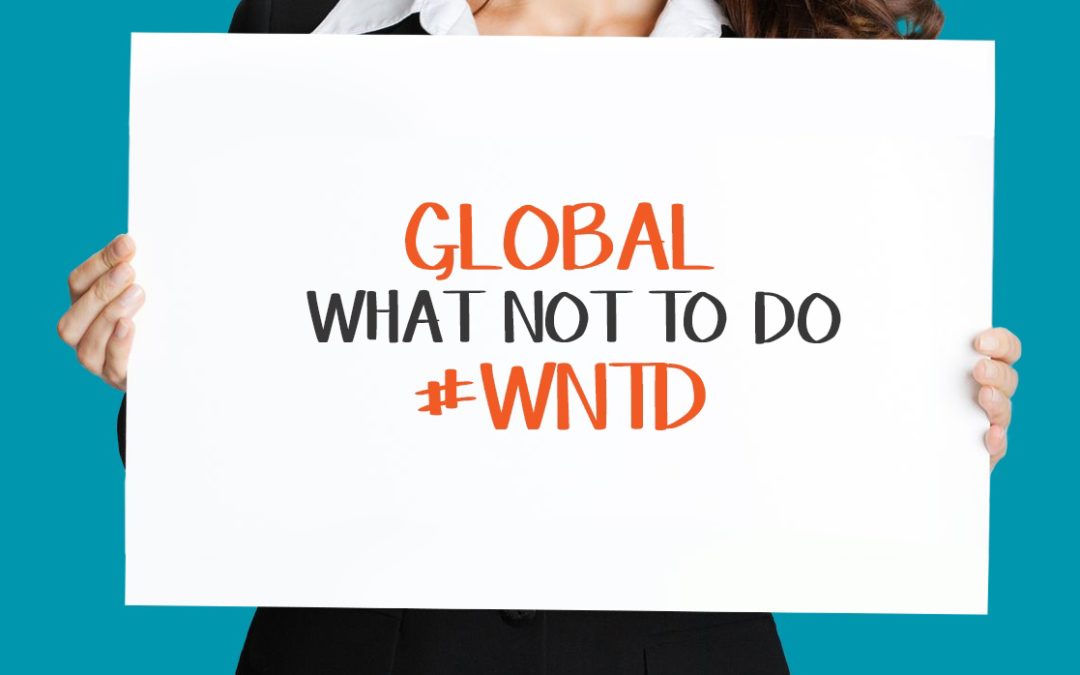Welcome to Part #3 of our global ‘What Not To Do’ series, aka #WNTD.
The fantastic tips keep rolling in. Thank you to all who have sent us your advice. Please keep the tips coming, email yours to editor@globig.co.
#WNTD tips from Eric Snethkamp, Global Channels and Strategic Alliances Manager, SafeGuard World International
1. Don’t “half a$$” your engagement with Independent Contractors—Your engagement with International IC’s MUST be in accordance with the rule of law for each location and failure to dot your I’s and cross your T’s can lead to a foreign government ruling your IC relationship was misclassified and that the IC should have been classified as an employee. Your liability in a misclassification claim could include past and current benefits, overtime payments, withholdings, contributions and much more. And, outside of the US employees have statutory entitlements that in many cases are far greater than in the US.
A few examples of scenarios that may define an Independent Contractor vs. an employee:
-Does the IC invoice you EVERY month?
-Does the IC have their own business cards for their business or yours?
-Are you the IC’s only client?
-Do you dictate 100% of the IC’s work activities?
2. Don’t go it alone. Every country has its own unique set of employment challenges. Just think about all the rules and regulations involved in employing here in the US. Not to mention the differences from state to state. Now consider all the different possibilities in various countries with various social norms, language barriers, time zones, currencies, statutory requirements etc. Trying to navigate and maintain expert knowledge is a challenge to say the least. The value of engaging with experts or outsourcing international employment, especially in cases where missteps can result in stiff monetary penalties in foreign jurisdictions, cannot be overstated.
#WNTD tips from Tyler Muse, CEO of Lingo Live
3. Companies are much more global today with offices around the world. Many end up communicating in English. Language barriers and cultural misunderstandings lead to lost productivity and revenue. Make sure your global teams can communicate well with each other. This might require some additional language training. Have a strategy to identify issues and help people increase their skills.
#WNTD tips from Denny Wong, W & H in Belgium
4. Some of “the biggest mistakes” I have seen when entering a new market is the selection and execution of the go-to-market strategy, i.e., using the top-down approach where HQ sent an ‘expat’ to the target market and expects fast results right away. And then keeping this model for too long before moving to a bottom-up approach using locals once there is traction. This is true for both B2B and B2C products or services.
5. Don’t treat localization as a ‘copy paste’ exercise or an don’t localize too early in the process before securing a good understanding of the target market by overly relying on ‘best practices’ without a real bearing on what is really needed. Hence the go big ‘fast’ or go bust approach could lead to costly mistake if not done correctly.
6. Don’t underestimate the complexity and time needed to get the foreign market up and running. We are often ‘too’ optimistic. As a rule of thumb, I always x2 the estimated resources, time, and effort to go ‘international’—to ensure that you manage a realistic expectation and SMART goal.
#WNTD tips from Anke Corbin, Founder and CEO of Globig, Startup Mentor
7. When posting on LinkedIn or other international group forums online, don’t just copy and paste your contact information with a list of products you sell in broken English into the comment section of a post. It makes you and your business look unprofessional and will turn people away. Respond to the actual message in the post, thank the person for sharing the information, develop an online rapport, and start a dialogue. Also make sure your contact information and profile are fully filled out on LinkedIn. People will look at your profile and reach out to you if you’re interesting, respectful, and someone they want to connect with.
Do you have a story or tip to share on what you’ve learned while taking your business into global markets? Send your Global #WNTD to editor@globig.co.
Don’t forget to join hundreds of other business leaders on Globig for the best international expansion tips, tools, and services around the world, it’s free! www.globig.co
